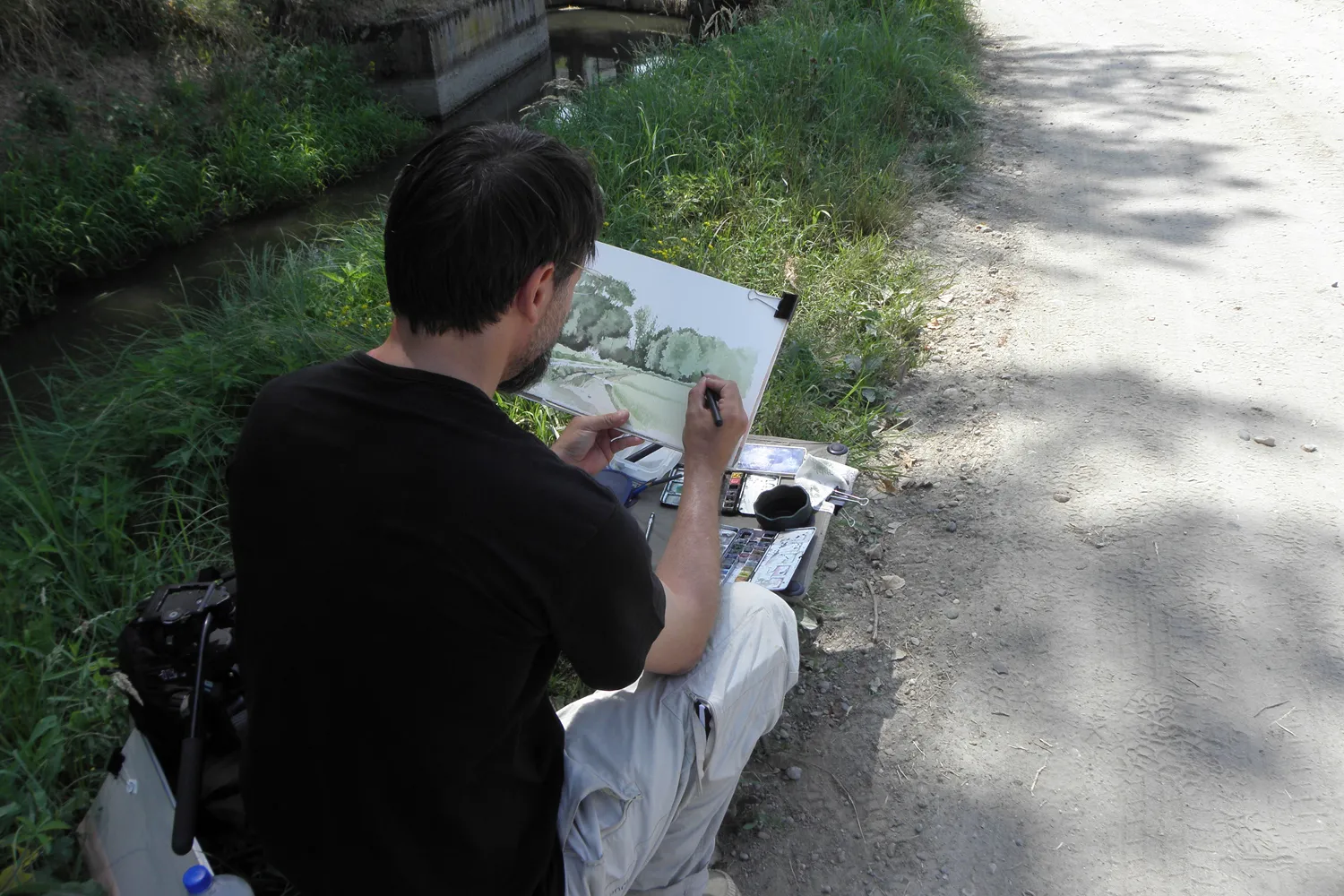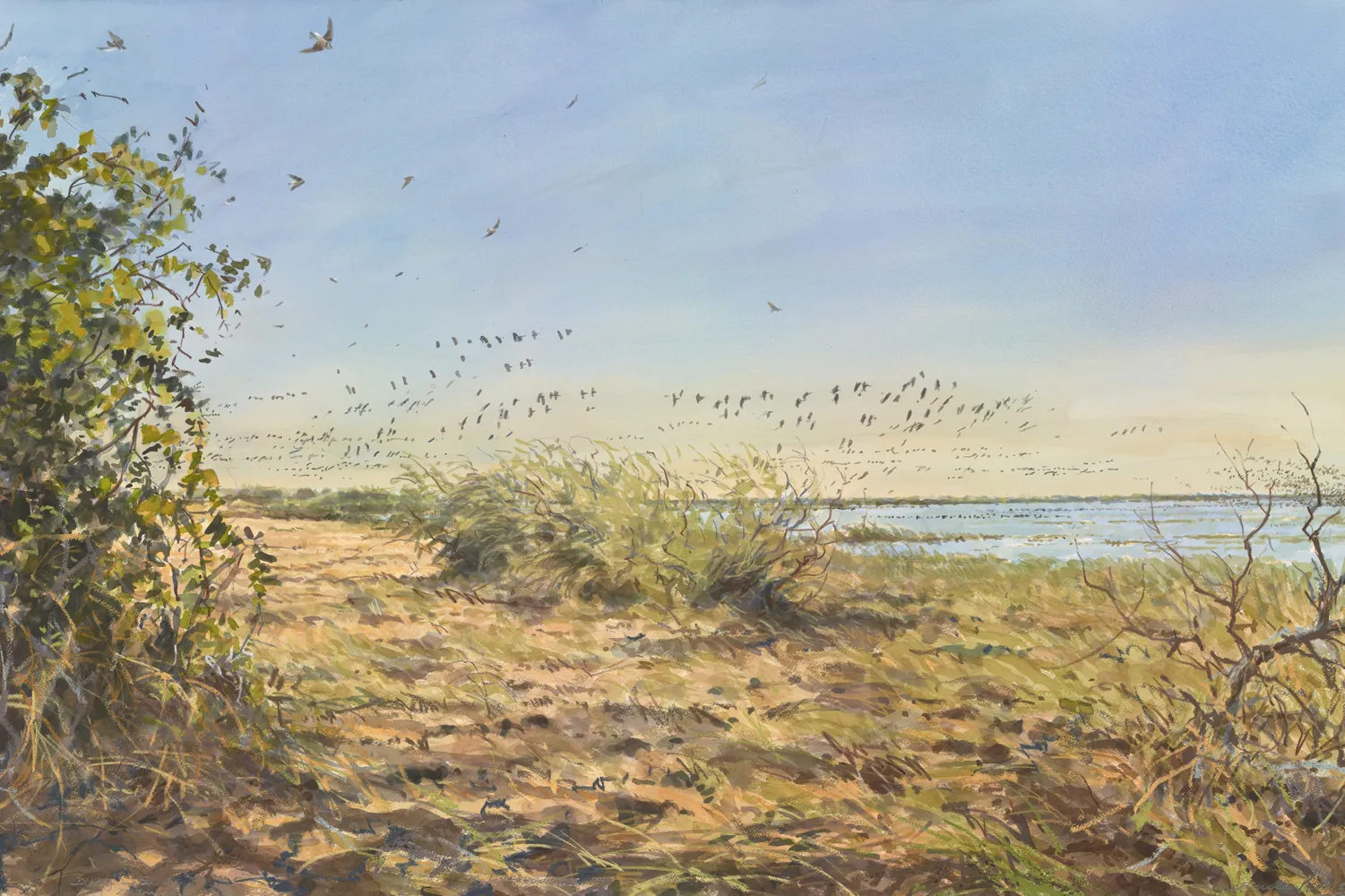Whether it is the sight of the summer’s first Swallow or the sound of a spring Cuckoo, the return of ‘our’ summer migrants delivers a reassuring sense of a globe that, as the poet Ted Hughes once described, ‘is still working’. That birds should undertake such long and dangerous migratory journeys is something that has long fascinated us, prompting works of art and literature, not to mention many thousands of scientific studies.
Now, at a time when many of our migrant birds are in decline, this fascination with migration has even more relevance. Our combined interest can be used to fund and support much-needed research, such as the work being done by the BTO and its partners, and to secure wider engagement with these iconic birds. The BTO’s Flight Lines project, a joint initiative with the Society of Wildlife Artists (SWLA), highlighted the challenges that migrant birds face and brought to a wider audience the research and conservation work being done to help these birds.
Where art and science meet
Bringing artists and scientists together delivers different perspectives on the same scene. Both question what they see, yet they look with different eyes. While science can provide the all-important evidence upon which conservation decisions and policy can be made, it is our emotional attachment to wildlife that will ultimately drive forward conservation action. Art and science are key players in delivering effective conservation action for migrant birds and other wildlife.
There were several strands to the Flight Lines project, a project made possible because of the generous legacy left by Penny Hollow. During the first year of the project we sent four artists to West Africa with our Head of International Research. The second year saw the development of work within the UK, bringing artists together with the volunteers who collect data on migrants, and in Italy, where many of our migrants stopover on their journey south. The third year sent a photojournalist and a storyteller to Gabon, to locations where satellite-tracked Cuckoos stopped. The final year of the project (2017) saw the publication of a book that added a narrative to the artwork and research to portray the secrets of our migrant birds.
Artists to Africa
In January 2014, a team of four Society of Wildlife Artists (SWLA) artists accompanied Dr Phil Atkinson, the BTO’s Head of International Research on a trip to Senegal. For the four artists, Robert Greenhalf, Bruce Pearson, Greg Poole and Esther Tyson, this was an opportunity to learn the context behind what they were seeing and sketching. Why did the landscape look the way it did? What were the birds doing and how were changes in these African habitats influencing their populations.
Many of Europe’s summer migrants winter in West Africa. Migrant waders, like sandpipers, Turnstone and Whimbrel, make use of the tidal wetlands near St. Louis in the north-west of Senegal, while the world-famous Parc National des Oiseaux du Djoudj holds hundreds of thousands, if not millions, of Sand Martin and high numbers of Sedge Warbler, Yellow Wagtail, Garganey and Chiffchaff. How many of our summer migrants return north to breed will be influenced, at least in part, by what happens to the habitats used on these African wintering grounds.
Some of the artwork from the 2014 trip was exhibited at the SWLA’s annual exhibition – The Natural Eye – at the Mall Galleries and more of the artwork was used in the Flight Lines book.

The journey south
While some birds make their migratory journey in a single flight, many others make one or more stops along the way to rest and refuel. These ‘stopover’ sites may be particularly important, with generations of birds using the same sites year after year. Once such stopover site is the Po watershed in northern Italy, an area that we know from satellite tracking is used by some of our UK Cuckoos.
During summer 2015, Dr Chris Hewson – the scientist leading on our Cuckoo-tacking research – accompanied Federico Gemma, a Society of Wildlife Artists (SWLA) artist, to the Po watershed. During their time on the watershed Chris and Federico caught up with migrant birds, as well as some locally-breeding species, attempting to capture a sense of the interchange of birds passing through the area and of the habitats the birds use.
Some of the artwork from the trip was exhibited at the SWLA’s annual exhibition – The Natural Eye – at the Mall Galleries, and at other exhibitions around the UK.

Gabon – in search of Cuckoos
A key component missing from our narrative on Cuckoo migration is the nature of their wintering grounds and the wildlife and human communities with which they share them. Thanks to our satellite-tracking work we know where they winter and we can view these sites through the images captured by orbiting satellites. However, we do not have a sense of what these places are like on the ground, nor do we understand how the Cuckoos are viewed by people in countries like Gabon, Cameroon and the Democratic Republic of Congo. Building a far more comprehensive picture of their African wintering areas provides a powerful frame for our evolving narrative around Cuckoo migration and decline.
In 2016, we sent photojournalist Toby Smith and storyteller Malcolm Green to Gabon, to secure a coherent picture of the wintering areas used by Cuckoos, the landscapes within which they sit and the elements of human culture and local wildlife with which they interact. Toby and Malcolm left for Gabon in mid-January 2016 with the aim of spending two weeks on the ground. The trip was funded through the BTO/SWLA Flight Lines project, with additional support from Toby, Malcolm and two anonymous donors, all of whom saw the importance of getting a real sense of where some of our birds winter.
On their return, Toby and Malcolm shared their experiences through a series of exhibitions and performances, viewed and watched by audiences new to the Cuckoo's story.

A lasting legacy
The Flight Lines project was made possible because of the generous legacy left by Penny Hollow and the kindness of her executors. Penny, a long-standing BTO member was a regular at the Society of Wildlife Artists (SWLA) exhibitions, a great supporter and a lay member of the SWLA. The bringing together of artists and scientists to raise the profile of our migrant birds is a fitting tribute to her interests.
The wider work carried out by BTO researchers is funded in many different ways. As a charity, the BTO relies on the generosity of those individuals, trusts and businesses who support its work to deliver the evidence and research outputs that underpin conservation action and policy decisions. If you would like to help the BTO in its work then find out more about fundraising, legacies and other ways of supporting what we do.
